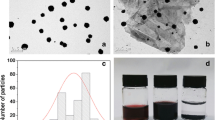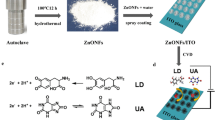Abstract
ZnO nanoflowers (ZnONFs) were synthesized by a simple hydrothermal method which is a convenient, environment-friendly, inexpensive process. The ZnONF suspension was sprayed onto the surface of ITO-coated glass (ZnONFs/ITO), which acts as the working electrode for the determination of levodopa by cyclic voltammetry and differential pulse voltammetry. The effect of reaction regents on the sizes of ZnONFs was investigated. The morphologies and structure of ZnONFs were characterized by scanning electron microscopy and X-ray diffraction analysis, respectively. The results show that the optimized length and diameter of ZnONFs are ~2.5 μm and 50 nm, respectively. The sensitivity and measured limit of detection of the ZnONFs/ITO electrode for levodopa are 0.10 μA/μM and 2.5 μM in the range of 2.5–40 μM, respectively. The electrode can accurately detect levodopa in the presence of uric acid. Meanwhile, the electrode shows good repeatability and stability.








Similar content being viewed by others
References
Ahmad R, Tripathy N, Hahn Y-B (2012) Wide linear-range detecting high sensitivity cholesterol biosensors based on aspect-ratio controlled ZnO nanorods grown on silver electrodes. Sensors Actuators B 169:382–386
Guo W, Li X, Qin H, Wang Z (2015) PEG-20000 assisted hydrothermal synthesis of hierarchical ZnO flowers: structure, growth and gas sensor properties. Phys E 73:163–168
Wang Y, Yang Y, Xi L, Zhang X, Jia M, Xu H, Wu H (2016) A simple hydrothermal synthesis of flower-like ZnO microspheres and their improved photocatalytic activity. Mater Lett 180:55–58
Cao X, Cao X, Guo H, Li T, Jie Y, Wang N, Wang ZL (2016) Piezotronic effect enhanced label-free detection of DNA using a Schottky-contacted ZnO nanowire biosensor. ACS Nano 10:8038–8044
Beitollahi H, Garkani Nejad F (2016) Graphene oxide/ZnO nano composite for sensitive and selective electrochemical sensing of levodopa and tyrosine using modified graphite screen printed electrode. Electroanalysis 28:2237–2244
Fouladgar M, Karimi-Maleh H, Gupta VK (2015) Highly sensitive voltammetric sensor based on NiO nanoparticle room temperature ionic liquid modified carbon paste electrode for levodopa analysis. J Mol Liq 208:78–83
Li J, Feng H, Jiang J, Feng Y, Xu Z, Qian D (2015) One-pot in situ synthesis of a CoFe2O4 nanoparticle-reduced graphene oxide nanocomposite with high performance for levodopa sensing. RSC Adv 5:99669–99677
Vilhena Rd O, Pontes FLD, Marson BM, Ribeiro RP, Carvalho K A T D, Cardoso MA, Pontarolo R (2014) A new HILIC-MS/MS method for the simultaneous analysis of carbidopa, levodopa, and its metabolites in human plasma. J Chromatogr B 967:41–49
Abdel-Ghany MF, Hussein LA, Ayad MF, Youssef MM (2017) Investigation of different spectrophotometric and chemometric methods for determination of entacapone, levodopa and carbidopa in ternary mixture. Spectrochim Acta A 171:236–245
Wang J, Cui L, Han S, Hao F (2015) Size-dependent active effect of cadmium telluride quantum dots on luminol-potassium periodate chemiluminescence system for levodopa detection. Appl Spectrosc 69:699–704
Song G, Villanuevafierro I, Ohira S, Mishra S, Bailiff H, Savage C, Dasgupta P (2008) Capillary scale liquid core waveguide based fluorescence detectors for liquid chromatography and flow analysis. Talanta 77:901–908
Teixeira MFS, Marcolino-Júnior LH, Fatibello-Filho O, Dockal ER, Bergamini MF (2007) An electrochemical sensor for l-dopa based on oxovanadium-salen thin film electrode applied flow injection system. Sensors Actuators B 122:549–555
Sheikh-Mohseni MA, Pirsa S (2016) Nanostructured conducting polymer/copper oxide as a modifier for fabrication of l-dopa and uric acid electrochemical sensor. Electroanalysis 28:2075–2080
Brondani D, Dupont J, Spinelli A, Vieira IC (2009) Development of biosensor based on ionic liquid and corn peroxidase immobilized on chemically crosslinked chitin. Sensors Actuators B 138:236–243
Halimeh Y, Hassan KM, Mohammad AK, Fatemeh K (2009) Electrocatalytic oxidation of levodopa at a ferrocene modified carbon nanotube paste electrode. Int J Electrochem Sci 4:993–1003
Arvand M, Ghodsi N (2014) Electrospun TiO2 nanofiber/graphite oxide modified electrode for electrochemical detection of l-DOPA in human cerebrospinal fluid. Sensors Actuators B 204:393–401
Arvand M, Ghodsi N (2012) A voltammetric sensor based on graphene-modified electrode for the determination of trace amounts of l-dopa in mouse brain extract and pharmaceuticals. J Solid State Electrochem 17:775–784
Rezaei B, Shams-Ghahfarokhi L, Havakeshian E, Ensafi AA (2016) An electrochemical biosensor based on nanoporous stainless steel modified by gold and palladium nanoparticles for simultaneous determination of levodopa and uric acid. Talanta 158:42–50
Tak M, Gupta V, Tomar M (2014) Flower-like ZnO nanostructure based electrochemical DNA biosensor for bacterial meningitis detection. Biosens Bioelectron 59:200–207
Zhang B, Lu L, Hu Q, Huang F, Lin Z (2014) ZnO nanoflower-based photoelectrochemical DNAzyme sensor for the detection of Pb2+. Biosens Bioelectron 56:243–249
Zhang Y, Zhang Y, Wang H, Yan B, Shen G, Yu R (2009) An enzyme immobilization platform for biosensor designs of direct electrochemistry using flower-like ZnO crystals and nano-sized gold particles. J Electroanal Chem 627:9–14
Xiang C, Zou Y, Sun L-X, Xu F (2009) Direct electrochemistry and enhanced electrocatalysis of horseradish peroxidase based on flowerlike ZnO–gold nanoparticle–Nafion nanocomposite. Sensors Actuators B 136:158–162
Acharyya D, Huang KY, Chattopadhyay PP, Ho MS, Fecht HJ, Bhattacharyya P (2016) Hybrid 3D structures of ZnO nanoflowers and PdO nanoparticles as a highly selective methanol sensor. Analyst 141:2977–2989
Zhang S, Chen HS, Matras-Postolek K, Yang P (2015) ZnO nanoflowers with single crystal structure towards enhanced gas sensing and photocatalysis. Phys Chem Chem Phys 17:30300–30306
Chen M, Wang Z, Han D, Gu F, Guo G (2011) High-sensitivity NO2 gas sensors based on flower-like and tube-like ZnO nanomaterials. Sensors Actuators B 157:565–574
Yue HY, Huang S, Chang J, Heo C, Yao F, Adhikari S, Gunes F, Liu LC, Lee TH, Oh ES (2014) ZnO nanowire arrays on 3D hierachical graphene foam: biomarker detection of Parkinson’s disease. ACS Nano 8:1639–1646
Xu C, Shin P, Cao L, Gao D (2014) Preferential growth of long ZnO nanowire array and its application in dye-sensitized solar cells. J Phys Chem C 114:125–129
Ahmad R, Tripathy N, Jang NK, Khang G, Hahn Y-B (2015) Fabrication of highly sensitive uric acid biosensor based on directly grown ZnO nanosheets on electrode surface. Sensors Actuators B 206:146–151
Babaei A, Babazadeh M (2011) A selective simultaneous determination of levodopa and serotonin using a glassy carbon electrode modified with multiwalled carbon nanotube/chitosan composite. Electroanalysis 23:1726–1735
Hariharan V, Radhakrishnan S, Parthibavarman M, Dhilipkumar R, Sekar C (2011) Synthesis of polyethylene glycol (PEG) assisted tungsten oxide (WO3) nanoparticles for l-dopa bio-sensing applications. Talanta 85:2166–2174
Wang J, Musameh M, Lin Y (2003) Solubilization of carbon nanotubes by Nafion toward the preparation of amperometric biosensors. J Am Chem Soc 125:2408–2409
Afkhami A, Kafrashi F, Madrakian T (2015) Electrochemical determination of levodopa in the presence of ascorbic acid by polyglycine/ZnO nanoparticles/multi-walled carbon nanotubes-modified carbon paste electrode. Ionics 21:2937–2947
Baghayeri M, Namadchian M (2013) Fabrication of a nanostructured luteolin biosensor for simultaneous determination of levodopa in the presence of acetaminophen and tyramine: application to the analysis of some real samples. Electrochim Acta 108:22–31
Raoof JB, Ojani R, Amiri-Aref M, Baghayeri M (2012) Electrodeposition of quercetin at a multi-walled carbon nanotubes modified glassy carbon electrode as a novel and efficient voltammetric sensor for simultaneous determination of levodopa, uric acid and tyramine. Sensors Actuators B 166-167:508–518
Kanchana P, Radhakrishnan S, Navaneethan M, Arivanandhan M, Hayakawa Y, Sekar C (2016) Electrochemical sensor based on Fe doped hydroxyapatite-carbon nanotubes composite for l-dopa detection in the presence of uric acid. J Nanosci Nanotechnol 16:6185–6192
Mazloum-Ardakani M, Khoshroo A, Hosseinzadeh L (2014) Application of graphene to modified ionic liquid graphite composite and its enhanced electrochemical catalysis properties for levodopa oxidation. Sensors Actuators B 204:282–288
Acknowledgements
This work is supported by the Natural Science Foundation of Heilongjiang Province (LC2015020), Technology Foundation for Selected Overseas Chinese Scholar, Ministry of Personnel of China (2015192), the innovative talent fund of Harbin city (2016RAQXJ185), and Science Funds for the Young Innovative Talents of HUST (201604).
Author information
Authors and Affiliations
Corresponding author
Additional information
Highlights
1. ZnO nanoflowers/ITO electrode prepared by hydrothermal synthesis and spray deposition.
2. ZnO nanoflowers with three-dimensional and large surface areas.
3. Higher sensitivity of 0.10 μA μM−1 for the detection of levodopa.
4. Excellent selectivity to determine levodopa in the presence of uric acid.
Rights and permissions
About this article
Cite this article
Yue, H.Y., Wang, B., Huang, S. et al. Determination of levodopa in the presence of uric acid using a ZnO nanoflower-modified indium tin oxide glass electrode. Ionics 23, 3479–3486 (2017). https://doi.org/10.1007/s11581-017-2153-3
Received:
Revised:
Accepted:
Published:
Issue Date:
DOI: https://doi.org/10.1007/s11581-017-2153-3




